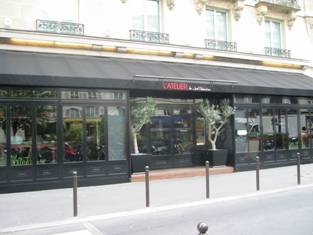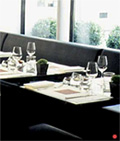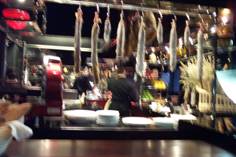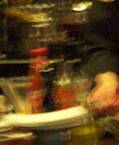Joël pulls a fast one!
In and out in an hour – and fifty quid the poorer – John Whiting takes you on a whirlwind tour of Joël Robuchon’s new Aletier which had opened on May 7 th, a month before.
 June 10 th 2003, 1958 hours L’Atelier de Joël Robuchon presents an austere black façade incongruously fronting the warm formality of a grand old hotel, the Pont Royal. When I arrive, about thirty would-be diners are lined up along the pavement outside its locked black glass door. They are neatly but informally dressed and so young as to make me wonder if they’re queuing for a disco. While I’m speculating as to how long I must wait, a burly queuemaster dressed in black and looking like a high-class bouncer emerges and utters a few curt words that are obviously intended to discourage. I follow him to the door and ask if there is a single place available. Ah! That is possible and I’m ushered into the sanctum sanctorum.
June 10 th 2003, 1958 hours L’Atelier de Joël Robuchon presents an austere black façade incongruously fronting the warm formality of a grand old hotel, the Pont Royal. When I arrive, about thirty would-be diners are lined up along the pavement outside its locked black glass door. They are neatly but informally dressed and so young as to make me wonder if they’re queuing for a disco. While I’m speculating as to how long I must wait, a burly queuemaster dressed in black and looking like a high-class bouncer emerges and utters a few curt words that are obviously intended to discourage. I follow him to the door and ask if there is a single place available. Ah! That is possible and I’m ushered into the sanctum sanctorum. 2001 hours As my eyes adjust to the subdued lighting, I make out rows of stools with deep maroon leather upholstery which dimly outline fingers projecting like fjords into the room. These connect to the work area, comprising the kitchen and service space, so that waiters may pass freely between the serving counter and the diners. 
I am taken to a far corner and shown to my appointed stool. It is a high metal frame, about 18 inches square, with a short straight back and a foot rest, and there is about 6 inches clearance on either side. I am more that 6 inches in width, but the stool beyond is unoccupied and so I am able to squeeze in without rubbing my posterior against an indignant diner.
I note that the last two spaces show signs of having recently been vacated. The restaurant has only been open an hour.
The counter space is a continuous ledge running the length of the bar. It is about a foot deep and steps up half a foot to a narrower ledge behind. My personal area is defined by a rectangular white plate about a foot wide, rather Japanesy, with a round depression in the middle, on which rests a starched white linen napkin rolled with surgical exactitude and held together by a maroon paper collar. L’Atelier de Joël Robuchon it announces boldly, in case I’ve forgotten where I am.
2004 hours The carte appears within two minutes of my being seated. Since I have seen it before, thanks to a friend’s photos of the window display, I’ve already decided on a menu that I can easily measure against familiar standards: foie gras, vitello tonnato and an assortment of tarts. This gives me a couple of minutes to look about before the waiter returns.
 From where I’m sitting I can easily survey the kitchen. There are a dozen or more workers, dressed in identical black uniforms. It is reported that Robuchon has gathered a small group of his peers for this venture, but there is only one chef who looks old enough even to be his son. The rest are mere toddlers.
From where I’m sitting I can easily survey the kitchen. There are a dozen or more workers, dressed in identical black uniforms. It is reported that Robuchon has gathered a small group of his peers for this venture, but there is only one chef who looks old enough even to be his son. The rest are mere toddlers.
The diners are not so easily observable, but the waiting queue has already convinced me that I must be by far the senior person in the room. If this is the way forward into the gastronomic future, it is a Children’s Crusade.
2006 hours The young waiter returns and takes my order. No sign of a wine list; I decide to wait for it to be offered. There’s time to observe a bit more.
The loudest sound is the subdued background music, a safely non-committal Vivaldi concerto. Perhaps conversation among the diners is inhibited by the seating arrangement, but that doesn’t keep a bar from being noisy. No, there is a conversational reticence, as in a church. We are receiving Holy Communion.
There is an equal silence in the kitchen area. Although it is mid-evening and all covers are occupied, many of the help are standing about like statues. There are none of the usual sounds of cooking – and, I suddenly realize, none of the smells. The activity in the kitchen seems to consist mostly of the assemblage of previously prepared ingredients.
2009 hours My first course arrives. The dining ledge is so far away from the waiter that he has difficulty setting the plate down and so, like the other diners I’ve observed, I help by taking it from him. The plate holds a glass ramekin about two inches across which contains a modest helping of cold foie gras with a bit of coarse salt. Accompanying it are four paper-thin slices of crisp pain Poilâne toast. Nothing wrong with the foie gras. It’s mildness suggests goose rather than duck, and though fresh, there’s nothing to distinguish it from the contents of an expensive jar. There’s no garnish. Inoffensive food for the well-to-do.
2010 hours A minute after my starter comes, the wine list is finally offered. I ignore the fine vintages – who would rush through such wines in such an ambiance?! – and opt for a glass of Sauternes to accompany the foie gras. 15cl of Chateau Rabaud Promis is available for 12 euros. (At that rate I could have a whole bottle for a mere 60, but I let it pass.) I leave my starter waiting in its little nest and the wine arrives within a couple of minutes. It is excellent but scarcely cool and will have reached room temperature well before I finish it.
 Having polished off the foie gras in a few mouthfuls, I have time for more observation. Over in the kitchen there’s some discernable activity. A small pile of ground meat appears on the workbench. Is there about to be some actual cooking and perhaps a suggestion of an aroma? No, it’s for steak tartare. The young chef produces a tray of condiments containing salt, pepper and two familiar objects. One is a plastic squeezie bottle of Heinz Tomato Ketchup, the other a small glass bottle of Lea & Perrins Worcestershire Sauce. I take out my camera, turn off the flash and capture a blurred record of culinary expertise in action.
Having polished off the foie gras in a few mouthfuls, I have time for more observation. Over in the kitchen there’s some discernable activity. A small pile of ground meat appears on the workbench. Is there about to be some actual cooking and perhaps a suggestion of an aroma? No, it’s for steak tartare. The young chef produces a tray of condiments containing salt, pepper and two familiar objects. One is a plastic squeezie bottle of Heinz Tomato Ketchup, the other a small glass bottle of Lea & Perrins Worcestershire Sauce. I take out my camera, turn off the flash and capture a blurred record of culinary expertise in action.
After mixing, the end product is ring-moulded into the compulsory cylinder and French fries added at the side of the plate. Another young kitchen helper comes over and shows the lad how to build them into a precarious tower, so that the extraction of a single stick will send the rest tumbling about the plate, thus embarrassing the diner.
2019 hours The waiter removes my plate, first putting my used cutlery back on the counter. There’s a dab of foie gras on the knife, which sticks to the foot of my wine glass. I wipe it off with my finger.
2021 hours Within a couple of minutes my vitello tonnato arrives. Six shavings of rare veal, about 4 inches by 2 inches, overlap across the plate. They are coated with a thin layer of tuna sauce and dotted with a few tiny capers. The veal is mild and tasteless, as pale veal tends to be. Like the foie gras, the sauce is pleasant and inoffensive. Invalid food. My remaining warm sauterne gives it a modicum of character. Stretching it out, I make it last ten minutes.
2035 hours My plate is taken away, this time along with the cutlery. Within a couple of minutes I’m offered the dessert menu. I’ve already decided on the selection of traditional tarts, just to sample the pastry chef’s expertise. What arrives is a plate containing a circle of six tiny wedges, each enough for two modest bites. The pastries are well-constructed and mostly of the pâte sucrée sort that doesn’t go soggy from waiting. One wedge is topped with three tiny wild strawberries (in context, the tame sort would have been Brobdingnagian) and another has a layer of tart lemon curd so light and foamy that you could suck it through a straw. The best mouthful I’ve had tonight.
2050 hours The dessert dish is removed and coffee is offered and accepted. Within a minute a demitasse arrives, together with a demi-sweet – a single truncated pyramid of toffee whose base is less than half an inch square. No need to worry about the calories.
2056 hours Five minutes later I am impatient to get back to the real world. I catch the waiter’s eye, scribble on my palm with my finger, and l’addition is produced. It comes to 71.5 euros. Fifty quid to eat at a cookery school! If you are in Paris in early June, get in touch with the Ecole de Paris des Metiers de la Table du Tourisme et de l’Hôtellerie. During their final examinations, a table for four, vin compris, will set you back a total of 30 euros.
I put my credit card on the tray and signal the waiter again. He saunters over, sees the card, and says without a note of apology, “Our machines aren’t working tonight. You must pay in cash.” “Suppose I didn’t have it,” I start to say, but he has already disappeared.
2058 hours I leave the exact change on the tray and collect my shoulder bag from under my stool, which I carefully manoeuvre backward to permit my egress without jostling my neighbours. Assistance from the staff? Don’t be ridiculous! None of them ever venture outside the designated work area.
I go to the front door, which is still locked against intruders. A couple of waiters notice me standing there but do nothing. In half a minute the queuemaster returns and goes through a couple of manipulations to undo the security. What would happen in case of fire? The Atelier would hold more seared meat than it will have witnessed in toto since it opened!
And so 2059 hours sees me back on the street, almost an exact hour from my arrival. What will the future hold? The name of Robuchon will no doubt take his Atelier safely through the warmer months. But when the seekers after novelty have come and gone, who among them will return? Who will wait outside on a winter night with no one to ask how long they must flail their arms and stamp their feet? Who, having been admitted, will be content with small chilly dishes served with an icy efficiency that will soon force them back into the greater cold?
And finally, how many of those who have thus sledged to the pole and back will then seek out the nearest bistro, where, for a fraction of the cost, they may relax over the warm comforting food they have been so expensively denied? I would like to believe that the great Joël Robuchon is a self-sacrificing counter-revolutionary who, by forcing a modern trend to its reductio ad absurdum, would thus bring us back to our culinary senses.
L'Atelier de Joël Robuchon, 5-7 rue de Montalembert 7th Tel: 01 42 22 56 56 Mº Rue-du-Bac
June 2009 Another negative report from another food blog:
For the dinner [at L’Atelier] in Paris, we showed up and not that unexpectedly were told we could be seated at 10 pm, two hours later -- a time we happily spent walking around the 6th on a delightful evening when many of the neighbouring antiques stores stayed open late. Upon returning, seats had freed up yet the maitre d' snootily insisted that we first wait in the bar of the hotel l'Atelier is connected to. We almost left after sitting in the charmless bar for twenty minutes, but it was my birthday and we felt we ought to wait it out. The food was mixed: e.g. a sensational dish of quail stuffed with foie gras (but where the foie gras was somehow on the outside) and, in contrast, an unbelievably mediocre tomato mozzarella salad. The portion sizes seemed to vary wildly, service was snooty and the meal was overpriced.
Back to the beginning of this review
